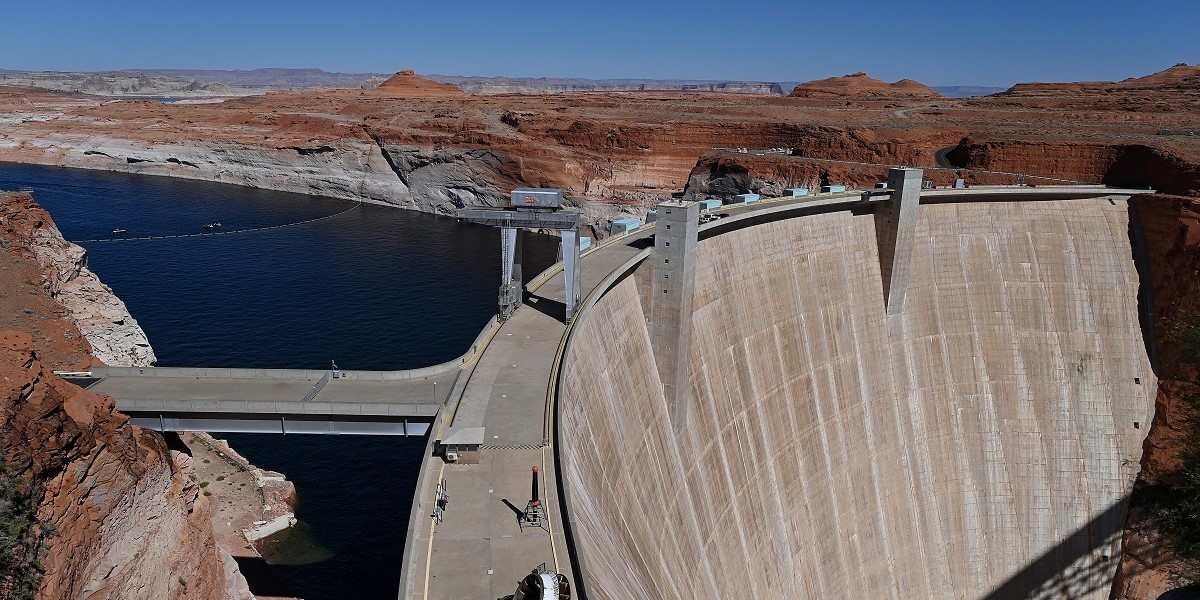
A worker drives a tractor in a dusty California field.
11:53 JST, February 1, 2023
For the second time in six months, states that depend on the Colorado River to sustain their farms and cities appear to have failed to reach an agreement on restricting water usage, setting up the prospect that the federal government will make unilateral cuts this year.
Six of the seven Colorado River basin states sketched out a joint proposal for how they could meet the federal government’s demand to make unprecedented cuts to water usage as more than two decades of drought in the West have pushed crucial reservoirs to dangerously low levels.
But the largest water user, California, did not join them – an impasse that suggests the wrangling over how to conserve the dwindling water supply that serves 40 million people will continue in coming months. The Interior Department had asked states to contribute by Tuesday plans for how to voluntarily reduce water usage by 2 to 4 million acre-feet – or up to one-third of the river’s annual average flow.
“Obviously, it’s not going swimmingly,” said Jeffrey Kightlinger, the former general manager of the Metropolitan Water District of Southern California, a water provider that is a major player in the talks. “It’s pretty tough right now.”
The proposal by the six states – Arizona, Colorado, Nevada, New Mexico, Utah and Wyoming – seeks to protect the major reservoirs in Lake Powell and Lake Mead from falling below critical levels, such as when the dams would no longer be able to generate electricity or at “dead pool,” when water would effectively be blocked from flowing out of these lakes. Before above-average snows in recent weeks, the Bureau of Reclamation was projecting that Lake Powell could start to reach such thresholds by this summer.

Lake Powell in Big Water, Utah.
During the past two decades of drought, and particularly in recent years, the river’s flow has declined, but states continue to consume more than the river provides, based on a framework established a century ago.
The proposal lays out potential new cuts for the states of the Southwest that lie downstream from the major reservoirs – Arizona, Nevada and California – as well as the country of Mexico, which has treaty rights to a portion of the river’s water. The proposal would result in about 2 million acre-feet of cuts – the low end of what the federal government has asked for – and would be largest for the biggest consumers of water: California and Arizona. As reservoir levels drop, the document suggests California, which has rights to 4.4 million acre-feet of water, would need to cut more than 1 million acre-feet.
California has offered to reduce just 400,000 acre-feet. An acre-foot is 326,000 gallons, or enough to cover an acre in water one foot deep. JB Hamby, chair of the Colorado River Board of California, told the Associated Press in a statement that the state “remains focused on practical solutions that can be implemented now to protect volumes of water in storage without driving conflict and litigation” and will submit its own plan.
The six other states made their case in a letter to the Bureau of Reclamation on Monday.
“We recognize that over the past twenty-plus years there is simply far less water flowing into the Colorado River system than the amount that leaves it, and that we have effectively run out of storage to deplete,” the states wrote. The state representatives added that they would continue to work together and with the federal government and others “to reach consensus on how best to share the burden of protecting the system from which we all derive so many benefits.”
“This modeling proposal is a key step in the ongoing dialogue among the Seven Basin States as we continue to seek a collaborative solution to stabilize the Colorado River system,” Tom Buschatzke, director of the Arizona Department of Water Resources, said in a statement.
Reclamation is in the process of an environmental review of how to operate Glen Canyon and Hoover dams at low-water scenarios. By the summer, the process is expected to clarify the federal government’s legal authority to make unilateral cuts to states’ water allotments.
One of the central tensions of these complicated negotiations is how to balance cuts between farming regions against those in cities, including major population centers. Agriculture uses some 80 percent of the river’s water and also tends to have the most senior rights, some dating back to the 19th century. The way this “priority system” works, residents of Phoenix would lose water before vegetable farmers in Yuma. Those who grow alfalfa in Southern California’s Imperial and Coachella valleys would keep their water before people in parts of Los Angeles.
Kightlinger, along with many other water experts and officials, says cuts of this magnitude and severity have to be shared, rather than doled out according to seniority.
“They can’t follow the priority system. That would be a disaster. That would be: We’re basically going to put all the cuts on the major share of the economy. That just simply can’t be reality,” he said.
But officials in these farming districts with long-standing water rights do not intend to give them up without a fight – or without compensation that meets their needs.
Alex Cardenas, the president of the board of directors of the Imperial Irrigation District, noted that the water rights among the farmers in his area of California near the border with Mexico predate the formation of the Bureau of Reclamation, which manages the river system. His water district uses about 2.6 million acre-feet of water per year to irrigate more than 400,000 acres of farmland for alfalfa, grasses and other crops.
“We stand behind the priority system on the river, and we also understand that there’s painful cuts that people need to make. But we will not serve as an emergency reservoir for uncontrollable, unsustainable urban sprawl,” Cardenas said. “We’re not going to wreck our local economy so that they can continue to grow their urban economy.”
As negotiations have progressed in recent months, the Imperial Irrigation District has offered to cut its usage by 250,000 acre-feet – or about 10 percent. The Biden administration helped pave the way for that offer by pledging $250 million for environmental projects to address the dust-ravaged shorelines around the Salton Sea, California’s largest lake, that’s fed by agricultural runoff from the Imperial Valley.
Cardenas said the prospect of a 10 percent cut to the region’s $5 billion agricultural economy would mean serious economic pain for a community that already suffers from high unemployment. But from the perspective of other states – even those cuts wouldn’t be nearly enough.
Negotiators have had a bit of help from nature to start the year. The rain and snowstorms that battered California in January raised reservoir levels in the state and coated the Sierra Nevada mountains in snowpack that is 210 percent above normal for this time of year. The snowpack in the Rocky Mountains, the main source of runoff that feeds the Colorado River system, is also higher than normal but not by as much as in California.
But the bountiful precipitation has also been a double-edged sword, creating a political challenge for negotiators trying to agree on painful cuts, according to analysts following the talks.
“If severe, extreme drought conditions continued, then it’s easier for them to sell additional cuts,” said Michael J. Cohen, a senior researcher with the Pacific Institute and an expert on the Colorado River. “But there’s this public perception that, ‘Look, there’s flooding. Why do we need to take additional actions now when there was so much water through all these recent storms?'”
The past two years have also seen healthy winter snow accumulation in the Rockies only to have runoff levels into Lake Powell that were a fraction of normal, as terrain dried out by the warming climate absorbed more of the water before it can reach the reservoir. The water level in Lake Powell has fallen about a foot this year and stands 33 feet above the threshold where Glen Canyon Dam could no longer produce power.
“There’s a problem of aridification. But on top of that, there’s a problem with the rules,” Cohen said. “The rules governing the system are not sustainable.”

The Glen Canyon Dam sits above Lake Powell and the Colorado River in Page, Ariz.
"News Services" POPULAR ARTICLE
-

American Playwright Jeremy O. Harris Arrested in Japan on Alleged Drug Smuggling
-

Japan’s Nikkei Stock Average as JGB Yields, Yen Rise on Rate-Hike Bets
-

Japan’s Nikkei Stock Average Licks Wounds after Selloff Sparked by BOJ Hike Bets (UPDATE 1)
-

Japan’s Nikkei Stock Average Buoyed by Stable Yen; SoftBank’s Slide Caps Gains (UPDATE 1)
-

Japanese Bond Yields Zoom, Stocks Slide as Rate Hike Looms
JN ACCESS RANKING
-

Keidanren Chairman Yoshinobu Tsutsui Visits Kashiwazaki-Kariwa Nuclear Power Plant; Inspects New Emergency Safety System
-

Imports of Rare Earths from China Facing Delays, May Be Caused by Deterioration of Japan-China Relations
-

University of Tokyo Professor Discusses Japanese Economic Security in Interview Ahead of Forum
-

Tokyo Economic Security Forum to Hold Inaugural Meeting Amid Tense Global Environment
-

Japan Pulls out of Vietnam Nuclear Project, Complicating Hanoi’s Power Plans




















